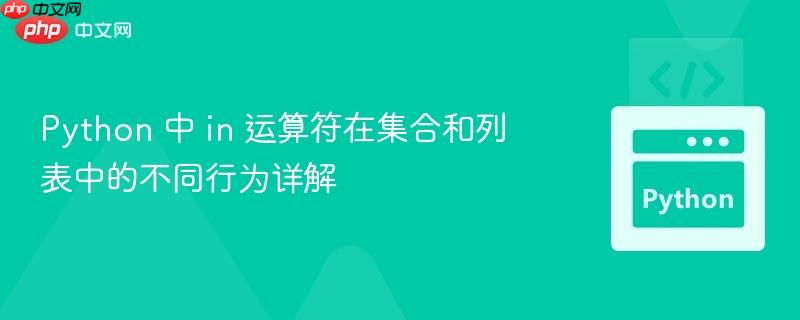
本文深入探讨了 Python 中 in 运算符在列表和集合等数据结构中的不同行为。通过分析其内部实现机制,解释了为何在处理 PyTorch 张量时,in 运算符在列表和集合中会产生不同的结果。此外,本文还提供了自定义类和代码示例,帮助读者更好地理解哈希表在集合查找中的作用,并针对特定问题提供有效的解决方案。
在 Python 中,in 运算符用于检查某个元素是否存在于一个集合(collection)中。然而,in 运算符的具体行为取决于集合的类型,尤其是集合是否使用了内部哈希表。 了解这些差异对于编写高效且无错误的 Python 代码至关重要。
in 运算符的工作原理
x in collection 的行为根据 collection 的类型而异。
不使用哈希表的集合 (列表、元组等)
对于不使用哈希表的集合,例如列表和元组,in 运算符会遍历集合中的每个元素,并逐个比较 x 和集合中的元素 c,直到找到匹配项。
其伪代码如下:
立即学习“Python免费学习笔记(深入)”;
def is_in(x, collection): for c in collection: if (x is c or x==c): return True return False
该过程首先比较对象的标识 (is),如果标识不同,则比较值 (==)。
使用哈希表的集合 (集合、字典等)
对于使用哈希表的集合,例如集合和字典,in 运算符会先计算 x 的哈希值,然后查找集合中具有相同哈希值的元素子集。
其伪代码如下:
立即学习“Python免费学习笔记(深入)”;
def is_in(x, collection): # 选择集合中哈希值与 x 相同的元素子集 subset = get_subset_by_hash(collection, hash(x)) for c in subset: if (x is c or x==c): return True return False
这种方法大大提高了查找速度,因为只需要比较哈希值相同的元素,而无需遍历整个集合。
示例:自定义类和哈希表
为了更好地理解 in 运算符的行为,我们可以创建一个自定义类 MyObj,并定义其哈希计算逻辑 (__hash__) 和相等性比较逻辑 (__eq__)。
class MyObj: def __init__(self, val, hashval): self._val = val self._hashval = hashval def __hash__(self): print(f"{str(self)} calling __hash__") return self._hashval def __eq__(self, other): print(f"{str(self)} calling __eq__, other={other}") return super().__eq__(other) def __repr__(self): return f"<{self.__class__.__name__}: {self._val}>"
然后,创建 MyObj 的几个实例,并将其添加到集合和列表中:
a = MyObj("a", 123) b = MyObj("b", 456) d = MyObj("d", 456) # 与 b 相同的哈希值 print("创建集合 `s`") s = set([a, b, d]) print("创建列表 `lst`") lst = [a, b, d]
运行这段代码会发现,在创建集合时,Python 会计算每个元素的哈希值,并且如果存在哈希冲突(例如 b 和 d 的哈希值相同),则会调用 __eq__ 方法进行比较。
接下来,可以使用 in 运算符来检查元素是否存在于集合和列表中,并观察其行为差异。
>>> s {<MyObj: a>, <MyObj: b>, <MyObj: d>} >>> b in s <MyObj: b> calling __hash__ True >>> d in s <MyObj: d> calling __hash__ <MyObj: b> calling __eq__, other=<MyObj: d> <MyObj: d> calling __eq__, other=<MyObj: b> True
在集合中,Python 首先计算 b 和 d 的哈希值。如果存在哈希冲突,则会调用 __eq__ 方法进行比较。
>>> lst [<MyObj: a>, <MyObj: b>, <MyObj: d>] >>> a in lst True >>> b in lst <MyObj: a> calling __eq__, other=<MyObj: b> <MyObj: b> calling __eq__, other=<MyObj: a> True >>> d in lst <MyObj: a> calling __eq__, other=<MyObj: d> <MyObj: d> calling __eq__, other=<MyObj: a> <MyObj: b> calling __eq__, other=<MyObj: d> <MyObj: d> calling __eq__, other=<MyObj: b> True
在列表中,Python 会依次比较每个元素,直到找到匹配项。
PyTorch 张量和 in 运算符
在使用 PyTorch 张量时,in 运算符的行为可能会有所不同。这是因为 PyTorch 张量重载了 == 运算符,如果两个张量的形状不同,则会引发 RuntimeError。
import torch a = torch.Tensor(2,3) b = torch.Tensor(2) # case 1a: # b in list([a,a,b]) # raises an error: # Traceback (most recent call last): # File "<stdin>", line 1, in <module> # RuntimeError: The size of tensor a (2) must match the size of tensor b (3) at non-singleton dimension 0 # case 1b b in set([a,a,b]) # True (i.e. no error)
在列表 [a, b] 中,当使用 b in [a, b] 时,Python 会首先比较 b is a(标识比较),如果结果为 False,则会比较 b == a(值比较)。由于 a 和 b 的形状不同,因此 b == a 会引发 RuntimeError。
在集合 {a, b} 中,当使用 b in {a, b} 时,Python 会首先计算 a 和 b 的哈希值。由于 torch.Tensor 的哈希值是其内存地址,因此 a 和 b 的哈希值不同。因此,b == a 不会被执行,从而避免了 RuntimeError。
解决方案
为了避免 RuntimeError,可以使用 torch.Tensor.size() 属性来创建不同大小张量的集合。
import torch # 创建不同大小张量的字典 tensor_dict = {} # 添加张量到字典 def add_tensor(tensor, tensor_dict): size = tuple(tensor.size()) # 将 torch.Size 转换为元组 if size not in tensor_dict: tensor_dict[size] = set() tensor_dict[size].add(tensor) # 检查张量是否存在于字典中 def tensor_in_dict(tensor, tensor_dict): size = tuple(tensor.size()) # 将 torch.Size 转换为元组 return size in tensor_dict and tensor in tensor_dict[size] # 示例用法 a = torch.Tensor(2, 3) b = torch.Tensor(2) add_tensor(a, tensor_dict) add_tensor(b, tensor_dict) print(tensor_in_dict(b, tensor_dict)) # 输出 True
总结
in 运算符在 Python 中是一个非常有用的工具,但了解其在不同数据结构中的行为至关重要。对于使用哈希表的集合,in 运算符的查找速度更快,但在处理特殊类型的对象(例如 PyTorch 张量)时,需要注意潜在的错误。 通过使用适当的数据结构和比较方法,可以编写高效且无错误的 Python 代码。


